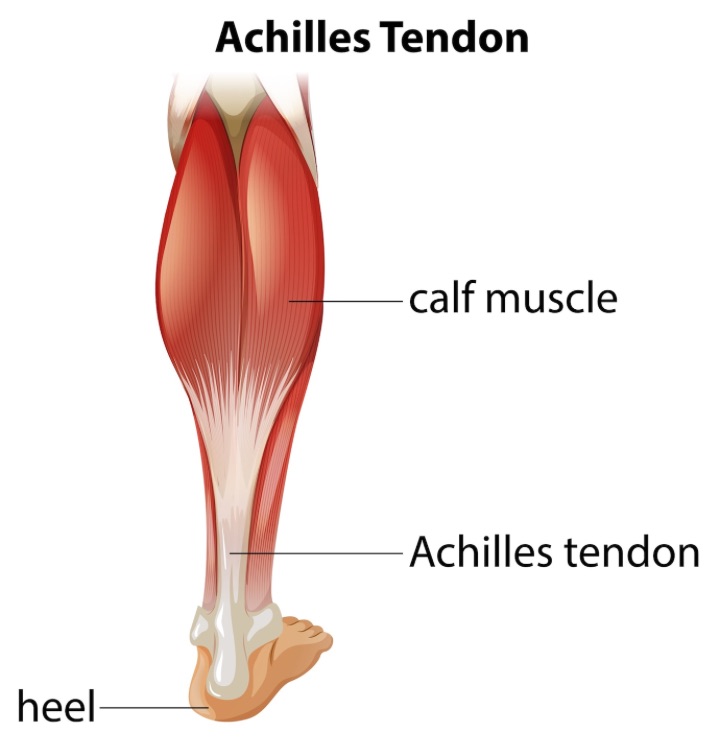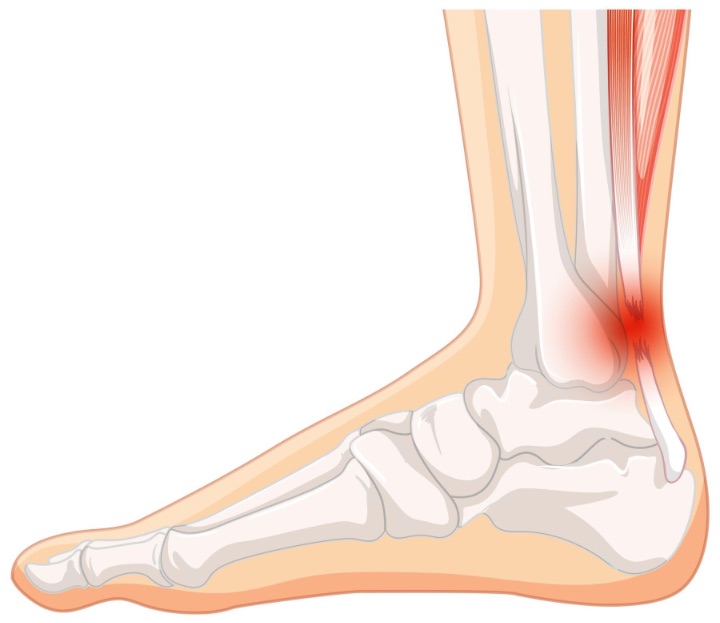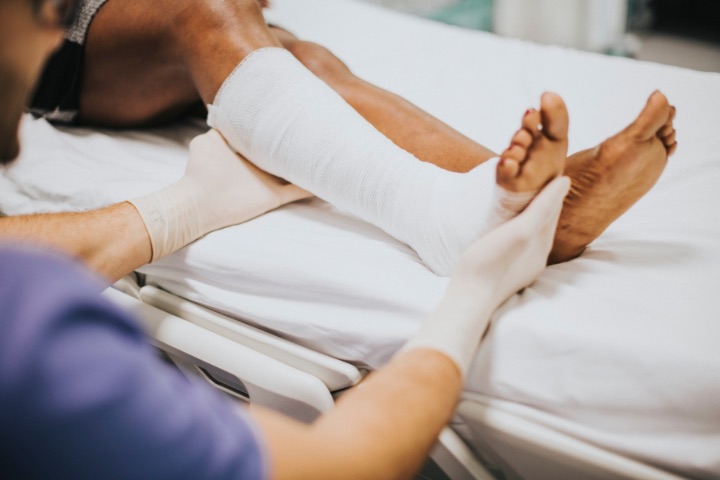Achilles tendon rupture is a painful and debilitating condition that can occur unexpectedly and cause discomfort for an extended period.
The Achilles tendon is a crucial component of the heel and ankle, responsible for many movements such as walking, running, and jumping. However, it is also a vulnerable part of the body that can be easily injured.
Achilles tendon rupture occurs when the tendon that connects the calf muscle to the heel bone is torn or fractured. It can happen suddenly during physical activity or over time due to repetitive strain on the tendon. Common symptoms include sharp pain, swelling, and difficulty in walking or standing.
If you suspect you may have an Achilles tendon rupture, it’s essential to seek medical attention promptly. Treatment options range from non-surgical approaches to surgical repair.
The appropriate treatment will depend on the severity of the injury and the individual’s circumstances. With the right care and treatment, the majority of patients experience successful recovery and return to normal activities.
The Achilles tendon is the largest and strongest tendon in your body. It connects the calf to your heel bone and plays a crucial role in walking, running, and jumping. The Achilles tendon allows the foot to move up and down, enabling us to perform various physical activities.

Photo Credit: brgfx
However, due to its high level of use, the Achilles tendon is prone to injuries and conditions like Achilles tendinopathy. This condition occurs when the tendon is overused and becomes inflamed, causing pain and stiffness in the heel and calf area. Other tendon injuries may also occur due to direct trauma or gradual degeneration.
The calf muscle works in tandem with the Achilles tendon to provide the necessary force for physical activities. Whenever the muscles in the calf contracts, it pulls the Achilles tendon, causing the foot to move. Thus, a well-functioning and healthy Achilles tendon is essential for proper leg movement and overall athletic performance.
Acute rupture of the Achilles tendon is a serious injury that can be caused by a variety of factors. The Achilles tendon, which connects the calf to the heel, is particularly susceptible to injury due to the amount of stress it is subjected to on a regular basis.
One of the most common causes of Achilles tendon rupture is a sudden, forceful movement that puts undue stress on the tendon. This can occur during activities such as jumping or landing awkwardly, or during sudden changes of direction while running.
There are several risk factors that can increase the likelihood of this condition. These include:
If you are experiencing symptoms of Achilles tendon rupture, such as pain, swelling, or difficulty walking or standing, it is important to seek medical attention as soon as possible. Your doctor can help to diagnose the injury and determine the best course of treatment.
In addition to the aforementioned risk factors, there are several underlying symptoms and causes of Achilles tendon rupture. These include:
The most common symptoms of Achilles tendon rupture include a sudden, sharp pain in the back of the ankle or calf pain, a popping or snapping sound at the time of the injury, swelling, and difficulty standing or walking on the affected leg. If you are experiencing any of these symptoms, seeking medical attention as soon as possible is important.
In order to accurately diagnose Achilles tendon rupture, a thorough physical examination along with systematic review of imaging techniques are often required.

Photo Credit: brgfx
An MRI or ultrasound may be performed to confirm the presence and extent of the injury. These imaging techniques can also help identify any other associated tendon problems or bone injuries in the foot and ankle area.
It can be classified as either partial or complete. A complete tear may be easier to diagnose due to the absence of tension in the affected tendon area, while a partial tear may require more advanced imaging techniques for an accurate diagnosis.
In some cases, advanced imaging techniques such as magnetic resonance imaging may be necessary to diagnose Achilles tendon rupture.
MRI provides a detailed image of the affected area, including the extent of the injury and any associated damage to bone or soft tissue. Ultrasound may also be used to produce a detailed image of the sinew and surrounding structures.
This condition can also cause involvement of the heel bone. This can lead to pain and difficulty walking. Imaging techniques such as X-rays or CT scans may be utilized to identify bone injuries caused by the rupture and determine the best course of treatment.
Surgery may not be necessary for some patients to treat a rupture of the Achilles tendon. Non-surgical treatments can be an effective alternative to surgery, depending on the severity of the injury and the patient’s overall health. Here are some common non-surgical treatments:
Studies have shown that non-surgical treatments can be effective for treating a rupture of the Achilles tendon in certain cases, and may have fewer complications than surgery.

Photo Credit: photoroyalty
However, it’s important to consult a doctor to determine the best course of treatment for individual cases.
If non-surgical treatment approaches have been exhausted or deemed ineffective, surgical intervention may be necessary. The type of surgical repair will depend on the severity and location of the rupture, as well as the surgeon’s preference.
Open surgery is the traditional method for treatment of acute Achilles tendon rupture. It involves making a single incision at the back of the ankle to expose the torn ligament.
The surgeon then sutures the two ends of the sinew back together. In some cases, additional reinforcement may be needed with other ligaments or synthetic materials.
While open surgery is effective, it is also associated with longer recovery times, higher risk of complications, and increased pain and scarring compared to the less invasive options.
Minimally invasive surgery, also known as percutaneous surgery, uses smaller incisions and specialized instruments to repair the ruptured tendon. The surgeon makes a few small incisions along the length of the sinew and uses a camera and other instruments to guide the repair process.
This technique is associated with shorter recovery times, less pain, and fewer complications compared to open surgery. However, percutaneous surgery may not be suitable for all types of ruptures.
It’s important to discuss surgical treatment options thoroughly with your doctor to determine the best approach for your specific case.
Recovering from a rupture of the Achilles tendon can be a lengthy process, and rehabilitation is crucial to ensuring a full recovery. The rehabilitation process usually starts with immobilization of the lower leg and ankle, which may be achieved with a protective boot or cast.

Photo Credit: rawpixel
As the sinew heals, patients may begin to engage in gentle exercises to improve range of motion and strength. Exercises may include calf stretches, towel scrunches, and toe curls.
It’s important to follow a structured rehabilitation program designed by a healthcare professional to ensure proper healing and avoid further injury.
During the healing period, it’s important to take extra care of the foot and ankle. Proper foot and ankle care can help to reduce swelling and pain and improve outcomes.
Patients can elevate the leg, apply ice to the affected area, and take over-the-counter pain relievers as directed by a healthcare provider.
It’s also important to avoid activities that put stress on the affected area, such as running and jumping, until cleared by a healthcare provider. Gradual reintroduction of activities should be done with caution, to avoid re-injury.
The Achilles tendon is a strong and resilient part of the body, but it can take time to regain its full strength after an injury. As patients progress through the rehabilitation process, exercises may become more challenging, with a focus on building strength and endurance in the lower leg.
Complications can include pain in the back, as the body compensates for the weakened tendon. Patients should report any persistent or worsening pain to their healthcare provider, as it may indicate a need for further evaluation or treatment.
With proper care and rehabilitation, most patients with a rupture of the Achilles tendon can expect a full recovery within several months. Follow-up with a healthcare provider is important to monitor progress and ensure a safe and successful return to normal activities.
Walking with a ruptured Achilles tendon is usually very difficult and painful. Some people might be able to hobble, but it is generally advised to avoid putting weight on the affected foot to prevent further injury.
A rupture of the Achilles tendon is a serious injury that often requires surgery followed by several months of rehabilitation. If left untreated, it can result in chronic pain, difficulty walking, and a decreased ability to participate in physical activities.
The healing time for a ruptured Achilles tendon varies widely based on the severity of the injury and the chosen treatment, but it typically takes between 4 to 12 months. Physical therapy is usually required during recovery to regain strength and mobility.
Signs of a potential rupture of the Achilles tendon include sudden and severe pain in the back of your ankle or calf, often described as being hit or kicked in the area.
There might also be a popping or snapping sound, immediate difficulty in walking or bearing weight on the foot, and swelling or bruising in the area.